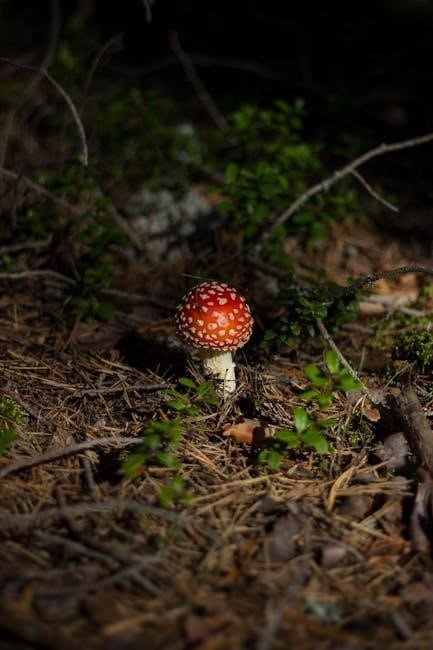Deborah Blum’s The Poisoner’s Handbook explores the birth of forensic toxicology in Jazz Age New York, tracing the pioneering work of Charles Norris and Alexander Gettler.
Overview of the Book
The Poisoner’s Handbook by Deborah Blum delves into the birth of forensic toxicology during the Jazz Age in New York City. The book recounts how poisons like arsenic and cyanide were once untraceable, making them tools for the perfect crime. Blum focuses on pioneers Charles Norris and Alexander Gettler, who revolutionized crime investigation through groundbreaking chemical analysis. Their work transformed the justice system, turning forensic science into a critical tool for solving murders. The book blends true crime, history, and science, offering a gripping narrative of how toxicology became a cornerstone of modern detective work.
Author Deborah Blum’s Background
Deborah Blum is a Pulitzer Prize-winning journalist and author, known for her compelling narratives that bridge science, history, and storytelling. A past president of the National Association of Science Writers, she is also a fellow of the American Association for the Advancement of Science. Blum has written several books, including The Poisoner’s Handbook, which highlights her ability to make complex scientific topics accessible and engaging. Her work often explores the intersection of science and society, earning her widespread acclaim for her meticulous research and vivid prose.
Historical Context of the Jazz Age
The Jazz Age, spanning the 1920s and early 1930s, was a period of cultural upheaval and scientific advancement in the United States. Prohibition fueled a rise in organized crime, while the era’s excesses and social changes created fertile ground for sinister plots. In this backdrop, poison emerged as a stealthy weapon, often undetectable and deadly. Deborah Blum’s The Poisoner’s Handbook captures this era’s tension, where the glamour of speakeasies and jazz masked the darker underbelly of murder and toxic intrigue, setting the stage for the birth of forensic toxicology.

The Birth of Forensic Toxicology
The early 20th century saw the emergence of forensic toxicology, driven by the need to detect poisons in corpses. This era marked a revolution in justice.
The Role of Charles Norris and Alexander Gettler
Charles Norris, New York’s first chief medical examiner, and Alexander Gettler, a pioneering toxicologist, revolutionized justice by developing methods to detect poisons in corpses. Their work laid the groundwork for modern forensic science, overcoming challenges like untraceable poisons and limited resources. Together, they transformed the field, ensuring justice for victims of poisoning and setting standards for forensic investigation. Their collaboration marked the beginning of a new era in criminal detection and public health safety.
Early Challenges in Poison Detection
In the early 20th century, detecting poisons in corpses was fraught with challenges. Limited scientific tools and unreliable methods, such as observing symptoms or feeding victims’ remains to animals, often led to inconclusive results. Poisoners frequently evaded justice due to the lack of advanced chemical analysis. This era of primitive forensic techniques made poison a seemingly perfect crime, highlighting the urgent need for innovative solutions in toxicology and criminal investigation.
Development of Forensic Science Techniques
The development of forensic science techniques in the early 20th century revolutionized poison detection. Pioneers like Charles Norris and Alexander Gettler introduced systematic chemical analysis, enabling the identification of toxins in human tissues. Their work led to breakthroughs in detecting substances like arsenic and cyanide, transforming criminal investigations. These innovations laid the foundation for modern forensic toxicology, ensuring justice and advancing public health.

Key Figures in the Book
Charles Norris and Alexander Gettler are central figures, pioneering forensic toxicology and transforming justice through their groundbreaking work in detecting poisons during the Jazz Age.
Charles Norris: Pioneer in Forensic Medicine
Charles Norris, New York’s first chief medical examiner, played a pivotal role in establishing forensic medicine. Collaborating with Alexander Gettler, he laid the groundwork for modern toxicology, overcoming limited resources and societal skepticism. Their work revolutionized criminal investigations, making it harder for poisoners to evade justice. Norris’s dedication and innovative approach transformed the field, setting a foundation for future advancements in forensic science and criminal justice systems.
Alexander Gettler: The Toxicologist
Alexander Gettler, a groundbreaking toxicologist, collaborated with Charles Norris to revolutionize forensic science. His meticulous methods for detecting poisons like arsenic and cyanide laid the foundation for modern toxicology. Gettler’s work in Jazz Age New York transformed criminal investigations, making it harder for poisoners to escape detection. His contributions established toxicology as a credible scientific field, paving the way for future advancements in forensic medicine and criminal justice.
Other Influential Scientists
Beyond Norris and Gettler, other scientists played pivotal roles in advancing forensic science. Figures like Edmond Locard, known for his work in trace evidence, and early chemists who developed detection methods, contributed significantly. Their collective efforts laid the groundwork for modern toxicology and criminal investigation. These scientists, often overlooked, were instrumental in shaping the field, ensuring that forensic science became a cornerstone of justice during the Jazz Age and beyond.

The Science of Poison Detection
The book delves into the evolution of poison detection, from primitive methods to advanced chemical analysis, revolutionizing how toxins were identified in the early 20th century.
Understanding Toxic Substances
The book examines the chemistry of toxic substances like arsenic, cyanide, and polonium, detailing their lethal effects and historical misuse. Early detection challenges arose from their invisibility in corpses, but advancements in forensic science transformed identification methods. Blum highlights how these poisons, once untraceable, became detectable through pioneering techniques, marking a turning point in criminal investigations and public health. The study of these toxins not only solved crimes but also laid the groundwork for modern forensic toxicology, as detailed in The Poisoner’s Handbook.
Breakthroughs in Chemical Analysis
The Poisoner’s Handbook highlights pioneering techniques in chemical analysis that revolutionized poison detection. Charles Norris and Alexander Gettler developed methods to identify toxins in corpses, overcoming earlier limitations; Their work introduced precise laboratory tests, such as spectroscopy and chromatography, enabling scientists to trace even minute poison amounts. These innovations transformed forensic science, making it possible to solve cases once deemed unsolvable. The breakthroughs not only advanced justice but also laid the foundation for modern toxicology, as chronicled in Blum’s gripping narrative.
Forensic Investigation Methods
In The Poisoner’s Handbook, Deborah Blum details the forensic investigation methods pioneered by Charles Norris and Alexander Gettler. They developed systematic approaches to detect poisons, including tests for cyanide, arsenic, and other toxins. Their methods involved meticulous laboratory analysis, combining chemistry with legal frameworks. These techniques transformed criminal investigations, enabling authorities to trace poisons in corpses and link them to suspects. The book highlights how these methods solved high-profile cases, bringing murderers to justice and establishing forensic science as a critical tool in law enforcement during the Jazz Age.
Notable Cases from the Book
The book highlights the infamous case of Frederic Mors, who confessed to multiple poisonings yet vanished, and other chilling murders that shaped forensic science’s evolution.
The Case of Frederic Mors
Frederic Mors, a notorious figure in The Poisoner’s Handbook, confessed to multiple poisonings but vanished, leaving no trace. His crimes exemplified the era’s weaknesses in detecting poisons, as forensic science was still in its infancy. Mors’s ability to evade justice highlighted the challenges faced by early forensic pioneers like Charles Norris and Alexander Gettler, who sought to develop reliable methods for detecting toxins. This case became a catalyst for advancing forensic toxicology, showcasing the urgent need for scientific progress in criminal investigations during the Jazz Age.
Other Murder Cases Involving Poison
Beyond Frederic Mors, The Poisoner’s Handbook delves into other chilling cases where poison was the weapon of choice. These incidents, often involving arsenic, cyanide, or other toxins, showcased the cunning of killers and the limitations of early forensic science. Each case pushed pioneers like Norris and Gettler to refine their methods, as they raced to detect untraceable poisons. These murders, steeped in deception, not only tested scientific boundaries but also revealed the darker side of human nature during the Jazz Age, leaving a lasting impact on forensic investigation techniques.
Impact of These Cases on Forensic Science
The cases detailed in The Poisoner’s Handbook revolutionized forensic science by highlighting the need for advanced toxicology methods. The challenges posed by untraceable poisons spurred pioneers like Norris and Gettler to develop groundbreaking techniques in chemical analysis. Their work not only solved crimes but also established forensic science as a critical tool in justice systems. These cases laid the foundation for modern toxicology, influencing detective work and public health policies, ensuring that poisons could no longer be used with impunity.

The Book’s Structure and Themes
The Poisoner’s Handbook is structured into chapters that blend crime narratives with scientific discovery, exploring themes of detection, justice, and the intersection of chemistry with history.
Chapter Overview
The book is divided into chapters that blend gripping crime stories with scientific insights, each focusing on a specific era or type of poison. Deborah Blum masterfully weaves historical narratives with detailed explanations of forensic breakthroughs, showcasing how pioneers like Charles Norris and Alexander Gettler transformed the field. From the detection of arsenic to the complexities of cyanide, each chapter highlights the cat-and-mouse game between poisoners and scientists. The structure ensures a seamless flow, making complex chemistry and history accessible to readers while maintaining a page-turning rhythm.
Themes of Crime and Detection
The Poisoner’s Handbook delves into the sinister world of Jazz Age New York, where poison became a stealthy tool for murder. The book explores the cat-and-mouse dynamic between criminals and scientists, highlighting how forensic toxicology emerged as a powerful weapon against undetectable poisons. Blum vividly portrays the era’s fascination with crime and the groundbreaking methods that transformed detection. Through gripping narratives, the book reveals how science triumphed over secrecy, reshaping the justice system and exposing the hidden dangers of a bygone era.
Historical and Scientific Intersections
The Poisoner’s Handbook masterfully intertwines the Jazz Age’s vibrant history with the dawn of forensic science. Deborah Blum highlights how the era’s fascination with modernity and crime collided with groundbreaking scientific advancements. The book explores the challenges of detecting poisons in the early 20th century, showcasing how pioneers like Charles Norris and Alexander Gettler revolutionized toxicology. By blending historical narrative with scientific discovery, Blum illustrates how the intersection of these fields transformed justice systems and laid the foundation for modern forensic investigation.

Reception and Reviews
The Poisoner’s Handbook received widespread acclaim for its gripping narrative and historical depth. Critics praised Deborah Blum’s ability to blend science, crime, and history into a compelling page-turner.
Critical Acclaim and Awards
The Poisoner’s Handbook earned widespread critical acclaim for its masterful blend of science, history, and true crime. Deborah Blum, a Pulitzer Prize-winning journalist, was praised for her meticulous research and engaging storytelling. The book was named a New York Times bestseller and received accolades from the scientific and literary communities. Blum’s work was recognized for its ability to make complex forensic science accessible and thrilling. Her credentials as a fellow of the American Association for the Advancement of Science added weight to her narrative, solidifying the book’s reputation as a landmark work in its field.
Reader Responses
Readers praised The Poisoner’s Handbook for its gripping narrative and meticulous research. Many found the blend of true crime and science fascinating, with some comparing it to a Raymond Chandler novel. The book’s ability to make forensic science accessible resonated widely, attracting both history buffs and fans of detective stories. Its educational value was highlighted, offering insights into the evolution of forensic medicine. Available in formats like PDF and Kindle, the book remains a popular choice for those intrigued by the intersection of crime and chemistry.
Comparison to Other True Crime Works
The Poisoner’s Handbook stands out in the true crime genre by blending meticulous scientific detail with a gripping narrative. Unlike many true crime books, it focuses on the scientific advancements that transformed criminal investigations. While works like those by Raymond Chandler emphasize detective drama, Blum’s book uniquely highlights the chemistry behind crimes. This blend of history, science, and murder appeals to fans of both true crime and science enthusiasts, making it a standout in the genre. Its availability in formats like PDF has further widened its reach.

Adaptations and Media
The PBS documentary American Experience (2014) brought The Poisoner’s Handbook to life, showcasing its impact on forensic science and captivating audiences beyond the book’s pages.
The PBS Documentary
In 2014, PBS’s American Experience released a documentary based on The Poisoner’s Handbook, bringing the story of forensic toxicology to life. The film delves into the pioneering work of Charles Norris and Alexander Gettler, highlighting their groundbreaking efforts in detecting poisons and solving crimes during the Jazz Age. It captures the era’s dark underbelly, where poison was a silent killer, and traces the evolution of forensic science. The documentary not only educates but also captivates, offering a visual narrative of Blum’s meticulously researched book.

Book’s Popularity in Media
The Poisoner’s Handbook has gained significant media attention for its gripping narrative and historical depth. Deborah Blum’s storytelling bridges science and true crime, making it a favorite among readers and critics. The book’s availability in formats like PDF has broadened its reach, appealing to a digital audience. Its blend of Jazz Age intrigue and forensic science has captivated media outlets, with many praising its ability to make complex chemistry accessible. This acclaim has solidified its place in popular culture, drawing comparisons to thrilling detective stories and historical dramas.
Impact on Popular Culture
The Poisoner’s Handbook has left a lasting mark on popular culture, inspiring a PBS documentary and captivating audiences with its blend of true crime and science. Its gripping narrative, often likened to detective fiction, has influenced how forensic science is portrayed in media. The book’s success has also sparked renewed interest in the history of poison and its role in criminal investigations, making it a cultural touchstone for both history enthusiasts and fans of the true crime genre.

Legacy and Influence
The Poisoner’s Handbook has inspired a PBS documentary and influenced modern forensic science, leaving a lasting impact on both criminal investigations and public understanding of toxicology.
Contribution to Forensic Science
Deborah Blum’s The Poisoner’s Handbook highlights the groundbreaking work of Charles Norris and Alexander Gettler, who pioneered forensic toxicology. Their innovative techniques for detecting poisons revolutionized criminal investigations, establishing a scientific foundation for justice. By developing precise chemical analyses, they transformed the field, making it possible to identify toxins in corpses. Their work not only solved murders but also laid the groundwork for modern forensic science, ensuring that poisons could no longer be used as undetectable weapons. The book underscores their enduring legacy in combating crime and protecting public health.
Influence on Modern Detective Work
The Poisoner’s Handbook has profoundly shaped modern detective work by detailing the origins of forensic toxicology. The book reveals how early 20th-century scientists like Charles Norris and Alexander Gettler developed techniques to detect poisons, laying the groundwork for contemporary crime scene investigations. Their methods, such as chemical analysis and toxicology, are now standard in forensic labs worldwide. Blum’s narrative not only highlights the scientific breakthroughs but also demonstrates how these innovations transformed law enforcement, enabling detectives to solve cases once deemed unsolvable. The book’s insights continue to inspire advancements in criminal justice and forensic science.
Deborah Blum’s Continued Work
Deborah Blum, a Pulitzer Prize-winning journalist, has continued to explore the intersection of science and storytelling. Beyond The Poisoner’s Handbook, she has authored books like Ghost Hunters and The Monkey Wars, delving into topics such as paranormal investigation and animal rights. Blum is also a professor at the University of Wisconsin-Madison, where she teaches science journalism. Her work consistently bridges the gap between complex scientific concepts and public understanding, making her a respected voice in both academia and popular media.
The Poisoner’s Handbook masterfully intertwines true crime, science, and history, showcasing the pivotal role of forensic toxicology in transforming justice. Deborah Blum’s compelling narrative ensures its enduring relevance.
The Poisoner’s Handbook by Deborah Blum chronicles the birth of forensic toxicology through the work of Charles Norris and Alexander Gettler in Jazz Age New York. The book highlights how these pioneers transformed the detection of poisons, overcoming early challenges and developing groundbreaking techniques. It explores notable cases, such as Frederic Mors, and their impact on forensic science. Blum weaves together true crime, history, and science, illustrating the cat-and-mouse battle between poisoners and scientists. The book underscores the legacy of Norris and Gettler, whose work laid the foundation for modern forensic medicine and criminal investigation.
Final Thoughts on the Book’s Significance
The Poisoner’s Handbook is a gripping narrative that bridges history, science, and true crime, offering insights into the evolution of forensic toxicology. Deborah Blum’s meticulous research and storytelling highlight the pivotal role of Charles Norris and Alexander Gettler in transforming criminal investigations. The book not only sheds light on the dark era of undetectable poisons but also celebrates the triumph of scientific ingenuity over crime. Its legacy lies in its ability to captivate readers with a tale of innovation, justice, and the enduring impact of pioneering work in forensic science.

